Bacterial Disease: Outbreaks of Cholera and Typhoid
Cholera and typhoid are a pair of bacterial diseases that can induce serious digestive system complications. Without adequate medical intervention, these diseases could be fatal. Both diseases are spread by eating or drinking contaminated food and/or water, which makes them particularly dangerous in areas that lack proper sanitation or drinking water.
Contaminated Food and Water: Breeding Grounds for Cholera
Symptoms of Cholera appear quickly as severe diarrhea and vomiting and if the disease is untreated can rapidly progress to dehydration pose a serious threat to life. Bacterium Vibrio cholerae, breeds in contaminated food and water and spreads as people drink or prepare food using the polluted water. Regions of the world that lack sufficient sanitation, including refugee camps and zones affected by natural calamities, often experience frequent cholera outbreaks.
Typhoid: Fecal Matter in the Water Supply
Typhoid fever infects impoverished areas of the world, where the few natural water sources that exist are polluted and toxic. Outbreaks occur frequently in Africa, India, Pakistan, and Bangladesh each of the last 50 years. Early symptoms include fever, headache, and stomach pain and as the disease advances, additional symptoms like diarrhea or constipation, along with weakness and exhaustion may appear. Like other waterborne bacteria, it multiplies in stagnant water, waiting to be ingested by unsuspecting victims. Fecal matter in the water supply is the main reason for outbreaks of Typhoid, which is difficult to suppress in densely populated urban areas like a refugee camp.
Treatment Protocols for Cholera and Typhoid
Antibiotics such as doxycycline and azithromycin are commonly employed in the treatment of cholera. These are particularly effective if the patient can consistently access clean drinking water for a minimum duration of three weeks. Typhoid, on the other hand, is routinely addressed with azithromycin, which has shown greatest efficacy when the infected individual is able to leave the contaminated environment for at least one month. However, an important issue to note is the development of resistance over time due to the continuous use of these and similar antibiotics, thereby reducing their effectiveness. The most reliable strategy for combating both cholera and typhoid, however, lies not in treatment, but in prevention. This can be achieved by maintaining proper sanitation standards and ensuring access to safe drinking water.
Immunization: Precautions for Visitors Travelling to areas infected with Cholera and Typhoid
In regions where cholera and typhoid are prevalent, visitors are advised to get their immunization shots before they travel. It is also recommended that visitors bring in their own bottled water and packaged food. However. visitors should be cautious and aware of the risk that these precious items could be stolen by black market dealers or people just trying to survive. Visitors should remain in the designated “safe-zones” within the infected areas for their own safety and should never eat raw or prepared food. It is suggested that visitors wear gloves and refrain from touching their face, even when wearing protection.
Six Common Waterborne Bacterial Infections that Occur right here in America:
---Shigellosis: Symptoms include diarrhea, abdominal cramping, and fever, which manifest during the first day after infection. Shigellosis, like most water source bacteria is transmitted by drinking water tainted with fecal matter deposited from those infected.
--- E. coli infection: Similarly, E. coli, is borne from standing water polluted with animal and human fecal matter and typically spreads from the eating of field grown vegetables washed using this tainted water.
--- Campylobacteriosis: Is a type of infection associated with the poultry industry and more specifically, factory farms and the poultry processing industry. Outbreaks occur when chicken manure gets into the water supply used to process the poultry.
--- Leptospirosis: LThis is an infection that first manifests as a fever, then a headache, muscle soreness, and finally vomiting. Leptospirosis outbreaks are rare in North America but common in Asia where a wide array of rodents is consumed. This bacterium thrives in water tailed with the urine of infected animals, especially rodents.
--- Listeriosis: Listeria is the most common of the water borne bacteria due to the inability to keep water sterile throughout the sorting, cleaning, preparation, and packaging stages of food processing. Listeria is introduced into the food supply from the soil and is difficult to detect and clean since the bacteria may be imbedded deep into the vegetable.
Prevention: The Growing, Processing and Cooking of Food
Avoiding outbreaks of waterborne diseases hinges on the adoption of proper sanitation and clean water use during the growing, processing and cooking of food.



.png)
.png)
.png)

.png)